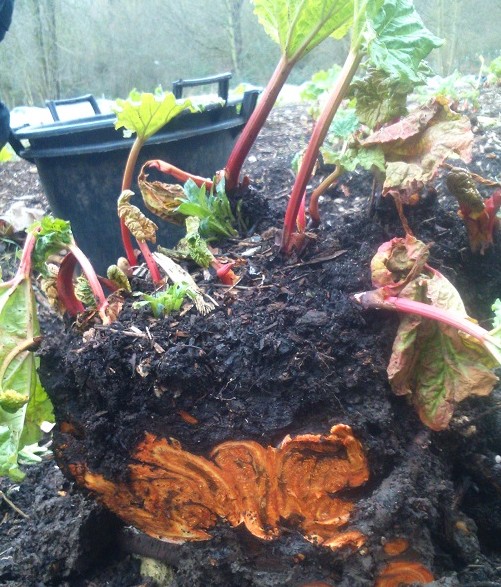Here in the United Kingdom Rhubarb enjoys a rather prestigious place in the culinary calendar. The pale pink slender stems of “Champagne Rhubarb” are both the ushers of spring and the first reliable cash crop of the year. No matter how much is grown at Organic Lea, the demand far outstrips the supply our mere 2 acres of diverse intensive farming can produce.
Champagne Rhubarb production is lucrative, but it can also be relatively expensive as the crop is grown in heated forcing sheds. Currently, nine square miles of West Yorkshire, is known as “The Rhubarb Triangle” and encompasses twelve farms. In 2010 these farmers approached the European Commission’s Protected Food Name scheme and were awarded Protected Designation of Origin status (PDO) for the term, “Yorkshire forced rhubarb.” Forcing Rhubarb is big business for some, however it can be done with some success in a low tech way small scale using your netting wires and a blackout cloth.
For many growers, Rhubarb is planted once. It’s widely accepted that some vegetables like Rhubarb, Asparagus and Jerusalem Artichoke, stay put when planted and remain indefinitely. Many successful allotments and growers subscribe to this thinking and harvest successfully year on year. Organic Lea is committed to using two of it’s acres to intensive organic farming and rotation is a key element in keeping both plants and soil healthy. This means that even crops that traditionally stay “forever” in one place are included in rotation, albeit for these crops they move once every four years.
This is year four for our early Rhubarb crop and the first year of it’s rotation, so this week we uprooted one of the four rows of Timperley Early and began the process of splitting and moving it to the area of the farm called The West Bank, or Salad Terrace. Over the years, the team have noticed that the Salad Terrace is the coldest plot on the farm. It is also the most over run with Horsetail. The thinking is, that Timperly Early will not suffer from the slightly colder micro climate and that with it’s maturity it’s wide leaves may also slow the rampant encroachment of one of the world’s oldest known “weeds.” Both of these factors have inhibited the Asparagus from reaching it’s full potential so we are effectively preforming an experimental swap of the two.
Splitting the Rhubarb serves two purposes, the first and most obvious is propagation. Mature crowns are quite easily split to produce multiple plants. To do this effectively one only need ensure each split contains both root and bud, we leave two to three buds in a spit.
The second reason for splitting is to cut away the heart. This may seem counter-intuitive, however the older a plant is, the more susceptible it becomes to disease. By lifting and splitting the crowns and cutting out the old growth we are taking preventative measures against potential disease in the crop. The oldest part, or heart then is added to our compost completing its circle.
